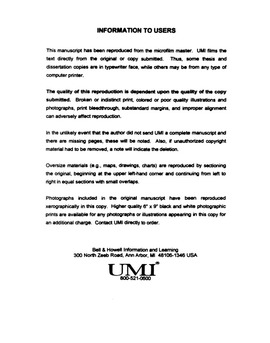| dc.contributor.advisor | Dunne, Timothy, | en_US |
| dc.contributor.author | Merrell, David Ray. | en_US |
| dc.date.accessioned | 2013-08-16T12:30:50Z | |
| dc.date.available | 2013-08-16T12:30:50Z | |
| dc.date.issued | 2000 | en_US |
| dc.identifier.uri | https://hdl.handle.net/11244/5927 | |
| dc.description.abstract | Finally, the creative destruction process can manifest itself in the growth of an establishment---as measured by changes in employment levels. That is, when sufficient information arrives through productivity signals, managers of an establishment can make decisions to expand or contract in size---usually by adjusting levels of employment. | en_US |
| dc.description.abstract | The creative destruction process manifests itself in the turnover and growth of establishments---where decisions as to exiting or changing employment levels (size) are based on signals received regarding an establishment's comparative advantage in the marketplace. Increasing (declining) productivity signals that a firm has a relative advantage (disadvantage) in an industry. Learning about relative productivity through market experience will provide managers with valuable information regarding the need to adjust to changing economic conditions. | en_US |
| dc.description.abstract | It has long been recognized that very dynamic processes underlie economic systems. Until recently, though, little was known about the engines that drive the dynamics of businesses and markets. The recent availability of large microdata sets has spawned focus on measuring the determinants of business growth and decline, success and failure. This dissertation contributes to the empirical evidence on the dynamics of the creative destruction process by presenting evidence on patterns of microeconomic adjustment dynamics in the U.S. coal mining industry and by examining different mechanisms available to establishments for adjusting to changing economic environments. | en_US |
| dc.description.abstract | An alternative form of turnover would be to offer the business (or establishment) for sale. In such a case, the creative destruction process does force turnover but not in the same sense as in the case of exit; rather, turnover occurs through changing control of an establishment from poorly performing managers or owners to presumably better performing managers or owners. The notion here is that declining productivity need not necessarily imply that there is something fundamentally wrong with an establishment (a case where turnover in the exit sense would occur) but that the comparative disadvantage could be a function of a poor match between owners (or managers) and assets. Offering an establishment for sale is a mechanism by which poorly performing assets can be allowed to migrate toward more productive control. | en_US |
| dc.format.extent | xi, 125 leaves : | en_US |
| dc.subject | Economics, Commerce-Business. | en_US |
| dc.subject | Coal mines and mining Economic aspects United States. | en_US |
| dc.title | Microeconomic adjustment dynamics in United States coal mining. | en_US |
| dc.type | Thesis | en_US |
| dc.thesis.degree | Ph.D. | en_US |
| dc.thesis.degreeDiscipline | Department of Economics | en_US |
| dc.note | Source: Dissertation Abstracts International, Volume: 61-02, Section: A, page: 0707. | en_US |
| dc.note | Adviser: Timothy Dunne. | en_US |
| ou.identifier | (UMI)AAI9962956 | en_US |
| ou.group | College of Arts and Sciences::Department of Economics | |
